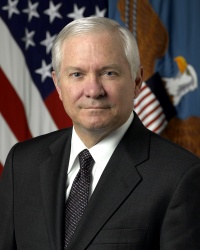Difference between revisions of "Robert Gates"
Tom Griffin (talk | contribs) m (→Pollard case) |
Tom Griffin (talk | contribs) m (typo) |
||
| (5 intermediate revisions by the same user not shown) | |||
| Line 1: | Line 1: | ||
| − | US Secretary of Defense | + | [[File:Robert Gates, official DoD photo portrait, 2006.jpg|200px|thumb|right|Robert Gates]] |
| + | [[Robert Gates]] is a former US Secretary of Defense. He also served as Director of Central Intelligence from 1991 to 1993.<ref>[http://www.defenselink.mil/bios/biographydetail.aspx?biographyid=115 Dr Robert M. Gates, Secretary of Defense],Defenselink, accessed 26 April 2008.</ref> | ||
==Pollard case== | ==Pollard case== | ||
| Line 5: | Line 6: | ||
==Realist faction leader== | ==Realist faction leader== | ||
| − | + | Jim Lobe argued that Gates was the leader of a realist faction in the Bush administration, rivalling the [[neoconservatives]]. | |
::The realist resurgence can also be traced to the rise of specific individuals, who took the place of their discredited predecessors in posts between the beginning of Bush's second term and the end of 2006 when the most important realist of all – Defense Secretary Robert Gates – replaced [[Donald Rumsfeld]] at the Pentagon. | ::The realist resurgence can also be traced to the rise of specific individuals, who took the place of their discredited predecessors in posts between the beginning of Bush's second term and the end of 2006 when the most important realist of all – Defense Secretary Robert Gates – replaced [[Donald Rumsfeld]] at the Pentagon. | ||
| − | ::With Gates heading Washington's most-powerful foreign-policy bureaucracy, the return to realism, which was already underway – albeit tentatively – as early as 2004, accelerated sharply. By the end of 2007, the administration's top hawk, Vice President [[Dick Cheney]], looks more isolated than ever.<ref>[http://antiwar.com/lobe/?articleid=12126 | + | ::With Gates heading Washington's most-powerful foreign-policy bureaucracy, the return to realism, which was already underway – albeit tentatively – as early as 2004, accelerated sharply. By the end of 2007, the administration's top hawk, Vice President [[Dick Cheney]], looks more isolated than ever.<ref>[http://antiwar.com/lobe/?articleid=12126 Gates Led Realist Resurgence in 2007], by [[Jim Lobe]], [[Antiwar.com]], 28 December 2007.</ref> |
==Affiliations== | ==Affiliations== | ||
| Line 18: | Line 19: | ||
[[Category:spooks|Gates, Robert]] | [[Category:spooks|Gates, Robert]] | ||
| + | [[Category:CIA|Gates, Robert]] | ||
Latest revision as of 13:47, 15 June 2013
Robert Gates is a former US Secretary of Defense. He also served as Director of Central Intelligence from 1991 to 1993.[1]
Pollard case
- Robert Gates, who became deputy C.I.A. director in April, 1986, told me that Casey had never indicated to him that he had specific information about the Pollard material arriving in Moscow. "The notion that the Russians may have gotten some of the stuff has always been a viewpoint," Gates said, but not through the bartering of emigres. "The only view I heard expressed was that it was through intelligence operations" -- the K.G.B.[2]
Realist faction leader
Jim Lobe argued that Gates was the leader of a realist faction in the Bush administration, rivalling the neoconservatives.
- The realist resurgence can also be traced to the rise of specific individuals, who took the place of their discredited predecessors in posts between the beginning of Bush's second term and the end of 2006 when the most important realist of all – Defense Secretary Robert Gates – replaced Donald Rumsfeld at the Pentagon.
- With Gates heading Washington's most-powerful foreign-policy bureaucracy, the return to realism, which was already underway – albeit tentatively – as early as 2004, accelerated sharply. By the end of 2007, the administration's top hawk, Vice President Dick Cheney, looks more isolated than ever.[3]
Affiliations
References
- ↑ Dr Robert M. Gates, Secretary of Defense,Defenselink, accessed 26 April 2008.
- ↑ The Traitor: The Case against Jonathan Pollard, by Seymour Hersh, The New Yorker, 18 January 1999, via JYA.
- ↑ Gates Led Realist Resurgence in 2007, by Jim Lobe, Antiwar.com, 28 December 2007.
